|


| |
New Mid-Century Empire Builder
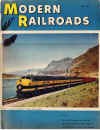
From the June 1951 issue of "Modern
Railroads" magazine
(note: see bottom of
article for color EB ad from inside back cover)

Great Northern expands its fleet of transcontinental streamliners
with a completely new Empire Builder.
JUST four years ago the Great Northern stepped out with an entirely
new fleet of diesel-powered streamliners for the long trip between
Chicago and the Pacific Northwest. Entirely new from nose to flashing
tail light were five trains. They put Great Northern's Pacific Northwest
service on a daily departure basis from all terminals with a record-
breaking 45 hour schedule for the 2211 miles.
The Burlington teamed up with the Great Northern to make this one
of the nation's foremost streamliners; for it handled the Empire Builder
between Chicago and St. Paul. The daily trains also gave the Burlington
another daily fast train in both directions on its Chicago-Twin
Cities service.
The Great Northern's determination to build its passenger service
hasn't rested there, however. Replacing the Empire Builder is a
completely new Mid-Century Empire Builder made up of five 15-car train
consists. And the five streamliners which since 1947 have carried the
Empire Builder name — still bearing all the appearances of new
equipment — are now being augmented by a sixth 14-car consist and re-
assigned as a companion streamliner named the Western Star.
Thus after only four years of diesel-powered streamline Empire
Builder operation Great Northern is doubling its capacity of modern
diesel powered transcontinental streamliners, at a cost of more than
$12 million for the rolling stock alone.
The Western Star with six 14-car trains takes over the schedule of
the Oriental Limited, which is being retired as a Great Northern train
name. With the two, the Great Northern and Burlington now have on
this transcontinental run two daily departures in both directions of
modern streamlined trains. The Empire Builder departs every day
from Chicago at 1:00 pm (CST) and arrives at Seattle at 8:00 am
(PST) and Portland at 7:30 am (PST) the second day. Portland is
reached from Spokane over the Spokane, Portland & Seattle Railway,
with two sleeping cars and a coach covering that leg of the route.
Eastbound departure is at 3:00 pm (PST) from both cities and arrival
at Chicago at 2:00 pm (CST) the second day.
The Western Star makes the run in 58 1/4 hours westbound and 55 1/2
eastbound. (Eastbound will be cut 30 minutes from present original time
of 56 hours.) It is timed to late-at-night departure from Chicago and
Seattle-Portland and an early morning arrival at the other end of the
run, thus operating three nights and two days. At Spokane westbound,
two cars leave the Western Star and become part of a connecting train
to Portland. The procedure is reversed eastbound. Between Spokane and
Seattle in both directions, an extra sleeper is added every night. Another
sleeping car, which comes out of Chicago westbound, is cut off at
Harve, Mont., and goes to Great Falls in a connecting train, reversing
the process eastward.
The features, characteristics, and services in both streamliners are
of such great diversity that they make both extremely versatile trains.
Such versatility is founded substantially on the experience the railroad
has had with the streamlined Empire Builder inaugurated in 1947. Its
effect has been to provide in each train as great variety of features and
services as is probably true of the variety in tastes, living habits and
personalities of the 333 passengers the Empire Builder accommodates
and 330 the Western Star accommodates.
There are coach accommodations with individual leg rests on the
reclining chairs. Each coach has extra-large lounges. The sleeping
accommodations include just about every type now available, from the
open section to the large bedroom which can be made up into a parlor
"en suite."
Before the 1947 Empire Builder was built the Great Northern's
passenger department surveyed its representatives throughout the
country on the types of accommodations preferred by its patrons. The
results of this survey definitely were in favor of having some open
sections on the train. Patronage of and demand for the open sections
on that Empire Builder plus a more recent survey made it apparent
that open sections should again be provided in the new Empire Builder.
Some passengers prefer the greater freedom of the open sections.
Frequently pairs ask for them. For still other passengers the budget is
the determining factor. They want sleeping accommodations but at the
lowest possible cost. Provision has accordingly been made for the
preferences of all three types of passenger.
Dining services on the new Empire Builder are in the center of the
train. In addition to the 36-seat diner, there is The Ranch — a lunch
counter-table service and lounge car. The Ranch is thoroughly western
in conception and decor with authentic cattle brands, saddle leather and
dude ranch color. At the end of the train is the semi-elliptical observation
lounge. All cars but the Pullmans have radio and public address
outlets. Other mechanical features provide a comfortable, quiet journey,
no matter what the weather may be like outside.
The Empire Builder is essentially a long-haul coach and sleeper train.
That in turn is one of the reasons why greatest emphasis in coach
accommodations has been placed on extra-roomy, comfortable accommodations.
Three of the four coaches on each train have 48 seats
with leg rests built into the reclining seats. The fourth coach has 60
reclining seats and is used principally to accommodate comparatively
short haul passengers.
The wisdom of placing such emphasis upon long-haul transcontinental
patronage has been borne out by the popularity of the Empire
Builder since its inauguration as a diesel-powered streamliner. It carries
considerable summer trade; and its month-in and month-out volume of
business people has increased steadily since 1947.
Repeat and Enlarge Popular Features
As a result of such popularity earnings of the streamlined Empire
Builder have been very gratifying. This has been one of the basic
reasons for putting on a second transcontinental streamliner
fleet — the Western Star. The Empire Builder also has had a marked effect in
bringing passenger business to the Great Northern — because of the high
standard of the train itself and also because it symbolized the road's
desire to offer the best possible in passenger service.

The observation-lounge car on the new Empire Builder is divided into
a lounge
section, in the foreground, and observation section by a wing
partition of
safety glass and red birch laminate. An attractive design is
sandblasted
in the glass. 
The
same type glass partitions as that used in the observation-lounge
divide the
diner into three sections and give it a unique decorative
effect.
Four-place tables are along one side of the diner and two-place
along the
other. 
The
color and spirit of the Old West are reflected in the smallest details
in the
"Ranch" coffee shop-lounge car. It is in three sections.
The photo
was taken from the 18-seat lounge. Next is the diner and then
the
lunch counter.

The
coffee shop-lounge has been made a full length car due to the
great popularity
of this type of car on the previous Empire Builder.
Murals behind the counter
were produced on hard, impervious
plastic sheets by a new process.
There is now a great similarity in the consists and features of both
the Empire Builder and the Western Star. Both have coach and sleeping
accommodations of the type in the most modern of postwar streamliners.
Other services are similarly comparable.
The coffee shop-lounge car is not only being repeated with The Ranch
on the new train but has greater capacity and is more elaborate than
the one on the Western Star, the previous Empire Builder (see following
article). This in turn speaks well for the success of that type car out on
the previous Empire Builder.
In the car built in 1947 the crew's dormitory was built into the car;
but on The Ranch the entire car is devoted to passengers, thus increasing
the capacity of this type service. The crew's dormitory is in the
baggage-dormitory car on the new Empire Builder which also accounts
for the 15-car consist of the Empire Builder compared with 14 cars for
the Western Star.
Response to a car with counter service when introduced in 1947 was
beyond the road's expectations, especially among coach passengers who
want a snack instead of a full meal or something in the snack or
beverage line between meals. It also is a car where they can "stretch"
or lounge in different surroundings than the coach.
Service in this car is available between 6:00 am and 9:30 pm.
Patronage is good during the entire time and also during all seasons
of the year. While it is intended primarily for coach passengers, sleeper
passengers also use it for sandwiches or light meals when they choose
this rather than a full meal in the dining car. Passenger reaction has
been excellent on all counts.
The conductor's office is in the 60-seater which is the first passenger-
carrying car in the train; so he is outside that car at all stops for
guiding and handling passengers. Intermediate stops have definite seat
assignments in the 60-seater for short haul business.
The passenger offices in Chicago and St. Paul hold all reservations for
48-seaters on the westbound train, and all other points get space
through the Great Northern's St. Paul reservation bureau. Eastbound,
48-seat space is held by Seattle, Tacoma, Vancouver, B. C., Spokane,
San Francisco, and Portland; and other points seeking space clear
through these offices.
Since the so-called 48-seat Day-Nite coaches are primarily for long-
haul service, and many of the passengers are women, it was decided
that having two ladies' rooms in these cars rather than one would add
to their travel comfort and convenience. The lounges are identical in
size and facilities and include vanities with mirrors.
A uniformed passenger representative is a member of each Empire
Builder crew. In addition to giving personal assistance to travelers, he
announces important train information and calls attention over the
public address system to points of scenic and historic interest. He also
operates the dinner-by-reservation plan through which passengers may
dine at the hour of their choice without standing in line for the evening
meal.
This plan was inaugurated when the streamlined Empire Builder
went into service in 1947. From the dining car standpoint it enables
better work and helps keep the car in better functioning order. It
has eliminated the problem of fitting passengers in from both ends of
a car, enabling smoother and more efficient serving of meals and
handling of passengers.
From the passenger standpoint, the passenger knows just when he will
eat, can choose his eating time and feels at ease knowing there will be
a seat for him. He doesn't have to stand in line before entering the
dining car, and isn't irked by believing passengers at the other end of
the car are getting a better break than he is.
The public address and radio system has outlets in all except the
sleeping cars. Selection of entertainment has been increased by installation
of equipment for reproduction of wire-recorded music.
Except for the 74-mile electrified zone between Wenatchee and
Skykomish, Wash., both streamliners are powered by Electro-Motive
diesel-electric locomotives. Between St. Paul and Wenatchee, a pool of
16 three-unit 4500-hp locomotives handles the six trains in the new
Empire Builder, the Western Star and the Fast Mail. A smaller pool of
two-unit 4000-hp locomotives handles them between Skykomish, Wash.,
the western end of the electrified zone, and Seattle.
ACCOMMODATIONS DELUXE
Regardless of how they prefer to travel, passengers will find
accommodations to their taste on the Mid-Century Empire Builder
IN order to put in service a second daily streamlined train
between Chicago and the Pacific Northwest the Great Northern has
obtained 95 new 85-ft cars which make up in six separate new
consists. Five of the consists are for the 15-car Mid-Century
Empire Builder and the sixth rounds out the Western Star fleet
of six 14-car consists so it too can operate over the 2211 mile
route in both directions with daily arrival and departure at
all terminals.

The 48-seat coaches have lots of room between seats. Comfort
is enhanced by combination foot and leg rest which slides out
from under the seat ahead. It is shown above when used
as a foot rest.
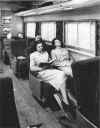
To convert the foot and leg rest for comfortable chaise lounge
effect, the foot piece from the seat ahead is turned over. These
long-distance travel coaches also have two fully outfitted lounges
for the women.
In design and construction the new Empire Builder embodies the
latest developments contributing to passenger comfort and safety.
But its most striking innovations are in the unique color,
styling, and decorative treatment. The striking appearance of
the interiors has come directly out of the scenery, resources,
and culture of the Northwest Empire served by the Great Northern,
as is evident by the illustrations accompanying this and the
preceding article.
Pullman-Standard built 59 of the new cars and American Car &
Foundry 36. In addition, the Great Northern has built six
streamlined baggage cars at its own shops for use on the
Western Star.
The 59 cars built by Pullman-Standard include:
18 48-seat coaches, 15 for the Empire Builder and 3 for
the Western Star
8 4-bedroom 16-duplex-roomette cars, all for the Western Star
16 2-compartment, 5-bedroom, 6-roomette cars, all for the
Empire Builder
16 1-compartment, 3-bedroom, 4-section, 7-duplex-roomette cars,
all for the Empire Builder
1 Observation-lounge for the Western Star
The 36 cars built by American Car & Foundry include:
6 60-seat coaches, all for the Empire Builder
6 Coffee shop-lounge cars, all for the Empire Builder
6 Dining cars, all for the Empire Builder
6 Observation-lounge cars, all for the Empire Builder
6 Baggage-dormitory cars, all for the Empire Builder
6 Baggage-mail cars, all for the Western Star
Structurally, the cars incorporate features of the postwar
streamline passenger car. They are of welded girder type
construction, with structural members of high strength alloy
steel.
The trucks are Commonwealth cast steel, four wheel, single
equalizer bar, all coil spring type, with roller bearings,
vertical shock absorbers and truck mounted air brake cylinders.
All trucks are equipped with anti-wheel slide devices.
The sleeping cars and coaches have Simplex clasp brakes and
the specialty cars have Budd disc brakes. All brakes operate
on a braking ratio of 250 percent of the lightweight of the
car with electro-pneumatic air braking.
The car interiors feature a number of ingenious, effective
design arrangements. This is most pronounced in the full length
coffee shop-lounge car, which has been named "The Ranch." As the
name implies, it is finished to give the rustic, homey feeling of
a western ranch house. As a passenger car, however, it is unique in the size
of the coffee shop section and the manner in which this section has
been combined with the lounge section.
The coffee shop section has a 25 ft 10-in. long counter seating 14.
At the end of the lunch counter opposite the kitchen and in
approximately the center of the car is a small dining section. It
seats 12, eight at two full tables along one side and four at two half
tables along the other side. Eight of the seats are built into the car
sides and four are movable chairs. This small dining section blends
into a lounge section which has nine comfortable lounge chairs
positioned against each side of the car.
Conceal Lights in Beams
In this car the spirit and color of the Old West is reflected in the
smallest decorative details. Its walls are finished in tongue-and-
grooved oak boards, sand-blasted and stained gray to heighten the rustic
effect of having been weathered a great length of time. The partitions
between the coffee shop, dining, and lounge sections and the low ceiling
section of the lounge at the car end are of vertical and horizontal
cedar logs simulating a corral fence. Other decorative effects have
been included to complete the western atmosphere of the car. A small
amount of Indian motif is utilized in the floor pattern and drapes.

Latest type, open section sleepers are included for those preferring
that type of accommodation.
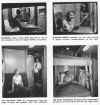
To avoid conflict with the rustic effect of the decoration, the
fluorescent light fixtures are concealed in oak beams, supported by
short oak studs fastened to exposed "root rafters" and crossbeams from
the outside walls. The arrangement in the coffee shop gives fine over-all
illumination because it was possible to utilize 180 deg of the light tubes
as effective usable light. In the low ceiling section of the lounge where
it was not practical to use the same beam arrangement, light is provided
by two incandescent half lanterns on the frieze panels. The fixtures
incorporate an Indian design.
The main decorative piece in the cars is a mural of a Montana roundup
scene. It covers the entire wall space back of the lunch counter
and is broken only at the coffee urn which was made in the shape of a
chuck wagon coffee pot.
In order to repeat the mural for the six cars in a medium very nearly
impervious to damage and yet maintain the full pictorial effect of the
mural, a new technique was employed. Silk screen prints were made of the
mural, then reproduced on a special micarta paper and then processed in
the same manner as Westinghouse's standard high pressure melamine
laminates. The finished murals are hard, impervious plastic sheets of
the same material used for table tops and window capping. The same
technique was also employed to make pictorial designs on other wall
surfaces of the cars in the train.
One further step was taken to change the "railroad look" in this car.
The ceiling, instead of curving at the sides down to the frieze panel,
is in the shape of a truncated pyramid which tilts like the root of a ranch
house.
In the new Empire Builder the dining car is immediately behind the
coffee shop-lounge car and has a contrasting motif. It features a
quiet, dignified arrangement in soft pastel colors. It seats 36, with 24
at six four-place tables along one side and 12 at six two-place tables
along the other side of the dining section.
The Angelo Colonna kitchens of both the diner and the coffee shop are of
stainless steel. The dining car kitchen includes such features as a propane
gas range, automatic dishwasher, automatic gas toaster, and electric
garbage disposal unit, and large mechanical refrigerators which include
frozen food compartments and three ice cube making compartments.
Because it was necessary to lower the ceiling at the locker end of the
dining section to accommodate the air conditioning unit, a portion of the
ceiling at the kitchen end was lowered to balance the arrangement. At the
end of each of the dropped ceiling sections there are two wing partitions
with 1/2 in. safety glass from window sill height to the ceiling. Each has
a design carved into the glass showing the most important industries
along the route of the Great Northern. They separate the dining section
into two end sections with a two- and four-place table and the
mid-section with four two- and four-place tables.
The buffets are covered in American Elm Truwood Micarta, the first time
this material has been molded in a high pressure laminate. The same
technique was also used in the observation lounge to obtain for the first
time a laminate with red birch on the exterior surface. This is the covering
on the wainscoting of the observation-lounge sections.
The observation-lounge car is divided into three parts: a semi-elliptical end
observation room with seating capacity of 18, a lounge room with seating
capacity of 18, and (toward the front end) the service facilities. These
include the bar room, general toilet, various lockers, three roomettes (for the
conductor, passenger representative and attendant), and the brakeman's
seat.
The lounge section is divided from the observation section by a
full height glass partition located between two triangular settees which
actually are back to back against the partition. Carved into the safety
glass partition by sandblasting is an attractive decorative pattern showing
the official state and province flowers. This pattern matches the
decorative treatment of the pier panel on the car.
The bulkhead at the forward end of the lounge section has an interesting
mural-type map of the Great Northern system which was moulded
in micarta in the same manner as the large mural behind the counter
in the coffee shop.
As mentioned in the previous article, there are two types of coaches
on the Empire Builder. Each train has three 48-seat Day-Nite coaches
and one 60 seat coach.
Having pioneered the 48-seat Day-Nite coaches in the first
transcontinental trains to be built in the postwar period, the new Mid-
Century Empire Builder again features this type of accommodation. The
48 Roto Cline seats, placed on 52 inch centers, are equipped with
chaise-lounge leg rests which pull out from under the seat ahead, making
it possible for the passenger to stretch out with his feet and legs
fully supported. The seats also feature individual ash trays and hammock
suspension in the back and seat.
Individual reading lights, controlled by the passenger, are provided
in each coach. Seat numbers, located on the edge of the baggage rack,
are illuminated. Each coach also has six radio speakers conveniently
located throughout the car for receiving radio programs and train
announcements. All the large double-pane picture windows have
Venetian blinds.
The comforts inherent in this type of coach arrangement are augmented
by spacious men's and women's lounges. At one end of the car,
in fact, are two complete, identical lounges for the women, with
identical dressing, toilet and lavatory facilities. A spacious lounge for men
is at the other end of each car.
A different and pleasing color combination was developed for each
of the three Day-Nite coaches.
Each of the trains also has a 60-seat coach for short distance travel
between intermediate points. These coaches have most of the features
of the Day-Nite coaches. Seats are equipped with foot rests and there is a
men's lounge at one end and a women's lounge at the other.
The six sleeping cars on each of the new Empire Builders include
every type of sleeping accommodation: lower and upper berths, single-
occupancy roomettes and duplex roomettes, double bedrooms,
compartments, and drawing rooms. Each bedroom and compartment has
a closed-off annex housing private toilet facilities.
Half of the sleeping cars on the Empire Builder combine in the one
car one compartment, three bedrooms, four sections, and seven duplex-
roomettes. The other half has two compartments, five bedrooms, and
six roomettes.


The four open sections in (he first mentioned cars are located at one
end convenient to spacious men's and ladies' dressing rooms. Upper
and lower berths in each section contain full berth facilities. The upper
berth provides adequate accommodations, with convenient lights, a
shelf to hold toilet articles, clothes hangers and a safety ladder for each
exit. The lower berth has individual lights, a hammock for clothes, a
shelf for sundry articles and two convenient clothes hangers.
In the cars which combine two compartments, five bedrooms and six
roomettes, four roomettes are placed at one end of the car and two at
the other, with the compartments and bedrooms in the center. Both
compartments are connected with single bedrooms, providing excellent
accommodations for family groups or business conferences.
Among the new cars built by Pullman-Standard also are eight four-
bedroom, 16-duplex-roomette cars for the Western Star. The bedrooms
are the conventional connecting type bedrooms separated by a folding
partition that permits the rooms to be kept as individual units or opened
to make one large room.
The 94 cars also embody many other mechanical features which contribute
to comfortable, safe, and quiet operation. All water pipes and
drains have anti-freeze protection. The cars are heated by the Vapor
zoned heating system with unit fin side wall radiation, supplemented by
an overhead unit built into the air conditioning system. The heating
system also features radiant panel heating at the windows, designed to
eliminate cold drafts which might occur during extremely cold weather.
The cars are cooled by Frigidaire electro-mechanical refrigeration
units with Trane evaporative compressors. The diner has an additional
three-ton Frigidaire electro-mechanical evaporator unit with a Trane
evaporative condenser. The seven-ton evaporator is for the dining room
and is located above the ceiling of one end of the dining section. The
three-ton evaporator is for the kitchen and is located above the
foyer for the kitchen.
Distribution of filtered air is through Anemostats in the individual
rooms and the smaller areas and Multi-Vent distributing panels in the
larger areas. »
Electric power for lighting and air conditioning on half of the cars
is furnished by a Waukesha Diesel Enginator under each of these cars,
consisting of a 60 hp diesel engine operating a 25 KW, 40 volt d-c
generator. On the other half of the cars a Safety 25 KW Genemotor
with Spicer drive is used as power source. Both Exide and Gould
batteries are used. On the cars with Enginators the battery is of 720
amp-hr rating and 1320 amp-hr batteries are used with the Genemotors.
The cars have Tightlock couplers and yokes and Waughmat twin
cushion draft gears. All end doors feature the National Pneumatic
automatic door opener.
The baggage-dormitory cars have a 30-ft baggage compartment at
one end and a crew's section with a steward's room at the other.
Accommodations for 21 men are built into the main dormitory which has
seven sections of three-tier bunks for the dining crews.


There are three toilets, five lavatories, two dental bowls, and a shower
bath for the crew. Four windows are on one side of the dormitory
section and three on the other.
The steward's bedroom is equipped with lockers, wardrobe, a folding
washstand and a shower bath. A conventional convertible sofa and
upper berth are provided.
The six new baggage-mail cars built for the Western Star conform
to the United States Post Office requirements in the 60 ft mail
apartment. A wardrobe for mail clerks is placed at the forward end of the
apartment on one side, of the car; and toilet, lavatory, refrigerator and
steam cooking equipment on the opposite side. The baggage compartment
occupies a 20 ft section to the rear of the mail apartment, combining
with the 30 ft baggage compartment in the baggage-dormitory
car which follows it.
Both trains feature the Great Northern's distinctive color scheme.
Alternating broad bands of olive green and deep orange are separated by
narrow strips of imitation gold. Lettering and numbering on the cars
in the Empire Builder is in imitation gold Scotchlite, a light-reflective
material which appears illuminated when automobile and other lights
shine upon it at night.
THE END
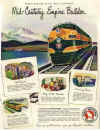
Full page color ad from inside back
cover of Modern Railroads, June 1951 issue.
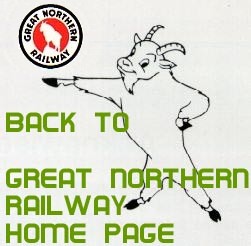 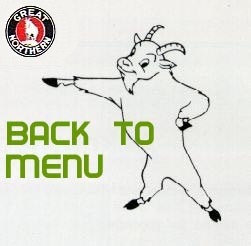 |